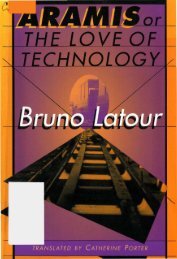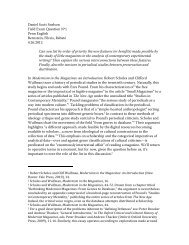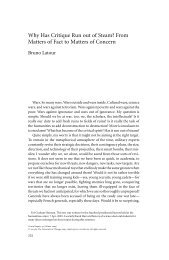The Exploit: A Theory of Networks - asounder
The Exploit: A Theory of Networks - asounder
The Exploit: A Theory of Networks - asounder
You also want an ePaper? Increase the reach of your titles
YUMPU automatically turns print PDFs into web optimized ePapers that Google loves.
142 Edges<br />
operates according to different relations <strong>of</strong> matter - form. Furthermore,<br />
metallurgy, or the idea <strong>of</strong> un métal pur, has nothing to do with the<br />
forging <strong>of</strong> swords or coins per se. “Not everything is metal, but metal<br />
is everywhere.” <strong>The</strong>re is a metallurgy that cuts across all complex<br />
matter, a sort <strong>of</strong> contagion <strong>of</strong> metallomorphic patterns, recombi na -<br />
tions <strong>of</strong> bits and atoms, a metalmorphosis <strong>of</strong> living forms that is not less<br />
ambivalent for its being metallurgic: “<strong>The</strong> huge population <strong>of</strong> viruses,<br />
combined with their rapid rates <strong>of</strong> replication and mutation, makes<br />
them the world’s leading source <strong>of</strong> genetic innovation: they constantly<br />
‘invent’ new genes. And unique genes <strong>of</strong> viral origin may travel, finding<br />
their way into other organisms and contributing to evolutionary<br />
change.” 48<br />
<strong>The</strong> Hypertrophy <strong>of</strong> Matter (Four Definitions and<br />
One Axiom)<br />
Definition 1. Immanence describes the process <strong>of</strong> exorbitance, <strong>of</strong> desertion,<br />
<strong>of</strong> spreading out. <strong>Networks</strong> cannot be thought without thinking<br />
about immanence (but not all networks are distributed networks).<br />
Immanence is not opposed to transcendence but is that which distributes<br />
in transcendence. Immanence is formally not different from<br />
self - organization. Immanence is ontologically not different from what<br />
Spinoza describes as causa sui.<br />
Definition 2. Emptiness is an interval. Emptiness is “the space between<br />
things,” or what in graph theory is called an edge. Emptiness is<br />
the absence <strong>of</strong> space, as if in itself. Emptiness is always “n1.” It is<br />
the pause that constitutes the network.<br />
Definition 3. Substance is the continual by - product <strong>of</strong> the immanence<br />
<strong>of</strong> emptiness. Substance is the effect, not the cause, <strong>of</strong> networks,<br />
akin to what graph theory calls a node. Substance is the point<br />
at which monism and pluralism implode. Substance is the indistinction<br />
<strong>of</strong> the one and the many, the production <strong>of</strong> the nodes that constitute<br />
a network.<br />
Definition 4. Indistinction is the quality <strong>of</strong> relations in a network.<br />
Indistinction is the “third attribute” never postulated by Spinoza<br />
(thought, extension, indistinction). Indistinction is not nondistinc-









